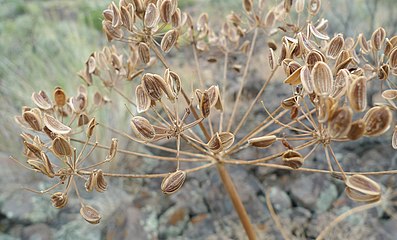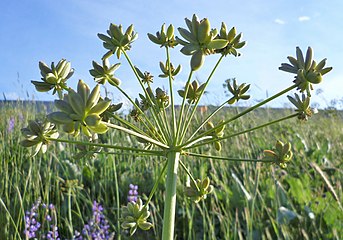en
names in breadcrumbs


Lomatium dissectum is a species of flowering plant in the carrot family known by the common names fernleaf biscuitroot and fernleaf desert parsley.[1] It is native to much of western North America, where it grows in varied habitat. It is found in the eastern slopes of the Cascade Range, Rocky Mountains, Klamath Mountains, eastern Transverse Ranges and the Sierra Nevada in California.
L. dissectum is a perennial herb reaching up to 1.2 metres (3 ft 11 in) tall,[1] growing from a thick taproot. The leaves are mostly attached near the base of the plant,[1] spreading with petioles up to 30 centimetres (12 in) long and large blades divided into many small,[1] narrow segments. The inflorescence is an umbel of many small yellow or reddish flowers, each cluster on a leafless stem[1] up to 10 cm long. The fruits resemble pumpkin seeds.
There are two varieties of Lomatium dissectum, both of which can be either yellow or purple in color when in bloom, but are distinguished by longer or shorter stalks on the fruit.[2]
Screening tests have been performed on root extracts of L. dissectum to assess its activity against viruses[3] and bacteria.[4]
{{citation}}: CS1 maint: uses authors parameter (link) {{citation}}: CS1 maint: uses authors parameter (link) Lomatium dissectum is a species of flowering plant in the carrot family known by the common names fernleaf biscuitroot and fernleaf desert parsley. It is native to much of western North America, where it grows in varied habitat. It is found in the eastern slopes of the Cascade Range, Rocky Mountains, Klamath Mountains, eastern Transverse Ranges and the Sierra Nevada in California.
L. dissectum is a perennial herb reaching up to 1.2 metres (3 ft 11 in) tall, growing from a thick taproot. The leaves are mostly attached near the base of the plant, spreading with petioles up to 30 centimetres (12 in) long and large blades divided into many small, narrow segments. The inflorescence is an umbel of many small yellow or reddish flowers, each cluster on a leafless stem up to 10 cm long. The fruits resemble pumpkin seeds.
There are two varieties of Lomatium dissectum, both of which can be either yellow or purple in color when in bloom, but are distinguished by longer or shorter stalks on the fruit.
Screening tests have been performed on root extracts of L. dissectum to assess its activity against viruses and bacteria.

Mature seeds of var. multifidum

Green seeds of var. dissectum